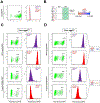Rescue of secretion of rare-disease-associated misfolded mutant glycoproteins in UGGT1 knock-out mammalian cells
- PMID: 38272446
- PMCID: PMC10832616
- DOI: 10.1111/tra.12927
Rescue of secretion of rare-disease-associated misfolded mutant glycoproteins in UGGT1 knock-out mammalian cells
Abstract
Endoplasmic reticulum (ER) retention of misfolded glycoproteins is mediated by the ER-localized eukaryotic glycoprotein secretion checkpoint, UDP-glucose glycoprotein glucosyl-transferase (UGGT). The enzyme recognizes a misfolded glycoprotein and flags it for ER retention by re-glucosylating one of its N-linked glycans. In the background of a congenital mutation in a secreted glycoprotein gene, UGGT-mediated ER retention can cause rare disease, even if the mutant glycoprotein retains activity ("responsive mutant"). Using confocal laser scanning microscopy, we investigated here the subcellular localization of the human Trop-2-Q118E, E227K and L186P mutants, which cause gelatinous drop-like corneal dystrophy (GDLD). Compared with the wild-type Trop-2, which is correctly localized at the plasma membrane, these Trop-2 mutants are retained in the ER. We studied fluorescent chimeras of the Trop-2 Q118E, E227K and L186P mutants in mammalian cells harboring CRISPR/Cas9-mediated inhibition of the UGGT1 and/or UGGT2 genes. The membrane localization of the Trop-2 Q118E, E227K and L186P mutants was successfully rescued in UGGT1-/- cells. UGGT1 also efficiently reglucosylated Trop-2-Q118E-EYFP in cellula. The study supports the hypothesis that UGGT1 modulation would constitute a novel therapeutic strategy for the treatment of pathological conditions associated to misfolded membrane glycoproteins (whenever the mutation impairs but does not abrogate function), and it encourages the testing of modulators of ER glycoprotein folding quality control as broad-spectrum rescue-of-secretion drugs in rare diseases caused by responsive secreted glycoprotein mutants.
Keywords: GDLD; TACSTD2; Trop-2; UGGT; UGGT1; UGGT2; glycoprotein secretion; responsive mutant.
© 2024 The Authors. Traffic published by John Wiley & Sons Ltd.
Conflict of interest statement
Figures







Update of
-
Rescue of secretion of a rare-disease associated mis-folded mutant glycoprotein in UGGT1 knock-out mammalian cells.bioRxiv [Preprint]. 2023 May 31:2023.05.30.542711. doi: 10.1101/2023.05.30.542711. bioRxiv. 2023. Update in: Traffic. 2024 Jan;25(1):e12927. doi: 10.1111/tra.12927. PMID: 37398215 Free PMC article. Updated. Preprint.
References
-
- Klausner RD, and Sitia R (1990). Protein degradation in the endoplasmic reticulum. Cell 62, 611–614. - PubMed
MeSH terms
Substances
Grants and funding
LinkOut - more resources
Full Text Sources
Medical
Molecular Biology Databases
Research Materials
Miscellaneous

